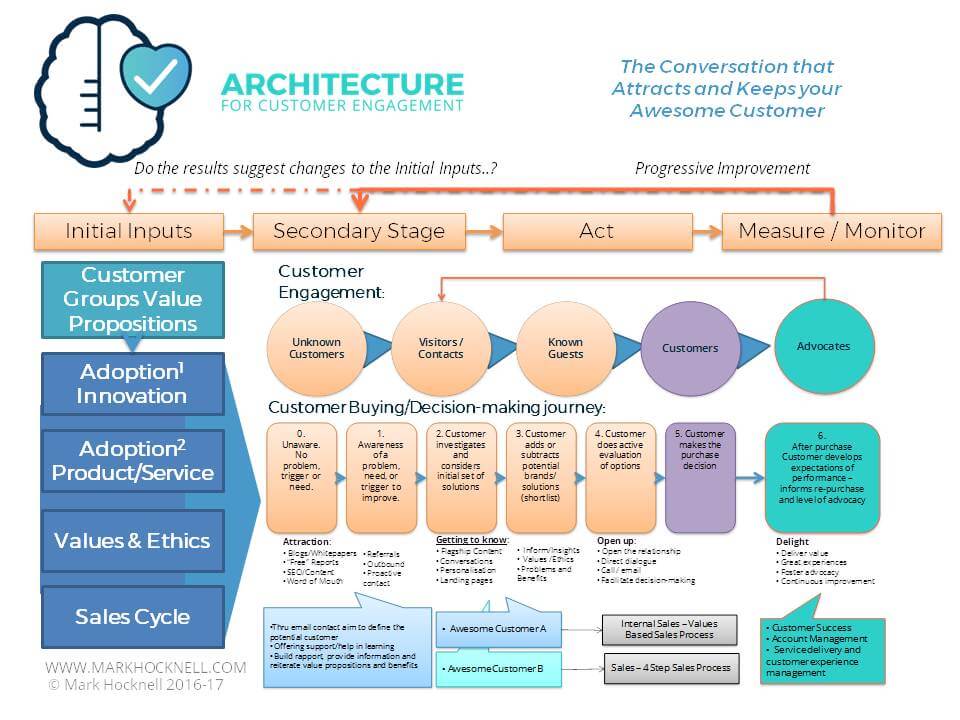
Customer Centric. Business Resilience.
The benefits of customer centricity have been well researched and documented (for example by Harvard Professor Ranjay Gulati and Forrester Research), but you do not become customer centric by bolting it onto your old approach.
To become customer centric and reap the benefits you need to adjust your approach. The benefits are, greater levels of engagement with employees and customers, who both become promoters of what you do; and higher levels of profitability and resilience in tough market conditions.
There are Five Tenets to the Customer Centric approach to Business that then provide us with the Nine Imperatives for Leaders. In many cases this is a relatively straightforward realignment of what you are already doing, but with a huge upside. If you adopt some of these principles, you will realise improvements. If you can apply and adopt all these imperatives your organisation will change and you will realise the full scope of benefits from becoming customer centric.
Whether you are thinking of an online presentation to get you started or multiple sessions to build capability, online sessions are proving highly valuable and accessible for all.
Develop your Customer Strategy, get started with Profit by Design, revise your sales leadership model, or customer engagement framework, it can be done online.

Download more information about these Online Masterclasses.
This video provides an explanation of the Customer Centric approach to Business
Most of our business practices we use today were developed through the Industrial Age. Today we are quickly moving into a digital age, and this has triggered a shift towards an experience economy. Customers have changed how they behave, employees have changed how they feel, therefore how we lead and manage has to change. We need to adapt our business and management practice to suit our age.
Want to know a little more, try these blog articles:
The New Path to Profitability and Engagement
The Five Tenets of the Customer Centric Approach to Business
Developing your customer strategy is the first step towards becoming customer centric.
Define your customer groups (not just segments but groups based on behaviours). Then, recognise the behavioural attributes for your more valuable customers, and understand the two-way value exchange. This will inform your efforts to increase the value of delivery to customers, and in turn the value of your customer portfolio. Your customer strategy will also inform your service and experience improvement efforts and investments.
Want to know a little more, try these blog articles:
Why your business needs a customer strategy
The value of your customer portfolio
Customer lifetime value explained
Leverage from the five tenets of the customer centric approach to business, for improved profitability and engagement.
Apply the Nine Imperatives for Leaders
Today, we all know that being customer-centric delivers business benefits, but most organisations that attempt to realise these benefits fail, or at best struggle to implement. The key insight is to change our approach. Bolting customer-centricity onto organisations designed for the last century does not deliver the goods. Understanding the principles behind customer centricity in the Five Tenets, and then applying the corresponding Nine Imperatives for leaders will align the organisation around being a Customer Centric Business.
How customer centric is your organisation..?
Research into customer centric businesses has shown that they are more profitable and resilient to market changes (such as recessions). Additionally, outside-in organisations have employees that are more engaged and more customer that are advocates.
This is a quick customer centric assessment you can do. Based on the Five Tenets of the Customer Centric approach to Business and the corresponding Nine Imperatives for Leaders, this self assessment will give you an overview of how customer centric you really are.
You can read more about the Customer Centric approach to Business in these blog articles:
The Five Tenets of the Customer Centric Approach to Business
The Nine Imperatives for Leaders
Applying the Architecture for Customer Engagement
Achieve alignment of your customer engagement activity to improve promoter behaviour and customer lifetime value.
Profit by Design™ can be used as a tactical approach to improving customer centricity, with short term benefits from greater alignment of resources and messaging, resulting in greater levels of engagement. This whitepaper describes the six principles behind Profit by Design™ and then an explanation of the Architecture for Customer Engagement. Includes a template for working on your own Architecture for Customer Engagement.
Read more
The ultimate question for advocacy
Most of us have answered the question "how likely are you to recommend this service to your friends, family and colleagues". We give it a score between zero and ten. When you ask your customers this question, if they score between zero and six, they are detractors and likely to give negative word of mouth about you. Those that score seven or eight are passive. Customers that score you nine or ten are promoters. That is they are likely to give you positive word of mouth, customer advocacy. Your net promoter score is the percentage of promoters you have over detractors.
Satisfaction scores measure a moment in time. NPS is a predictor of future behaviour.
Mark is a Net Promoter Certified Associate, and has implemented NPS into both B2B and B2C contexts.
Talk to Mark about your NPS.
If you want to develop a customer centric business, Mark is your man.

News
All the latest from the Mark Hocknell camp
How to Close the Strategic Gap






